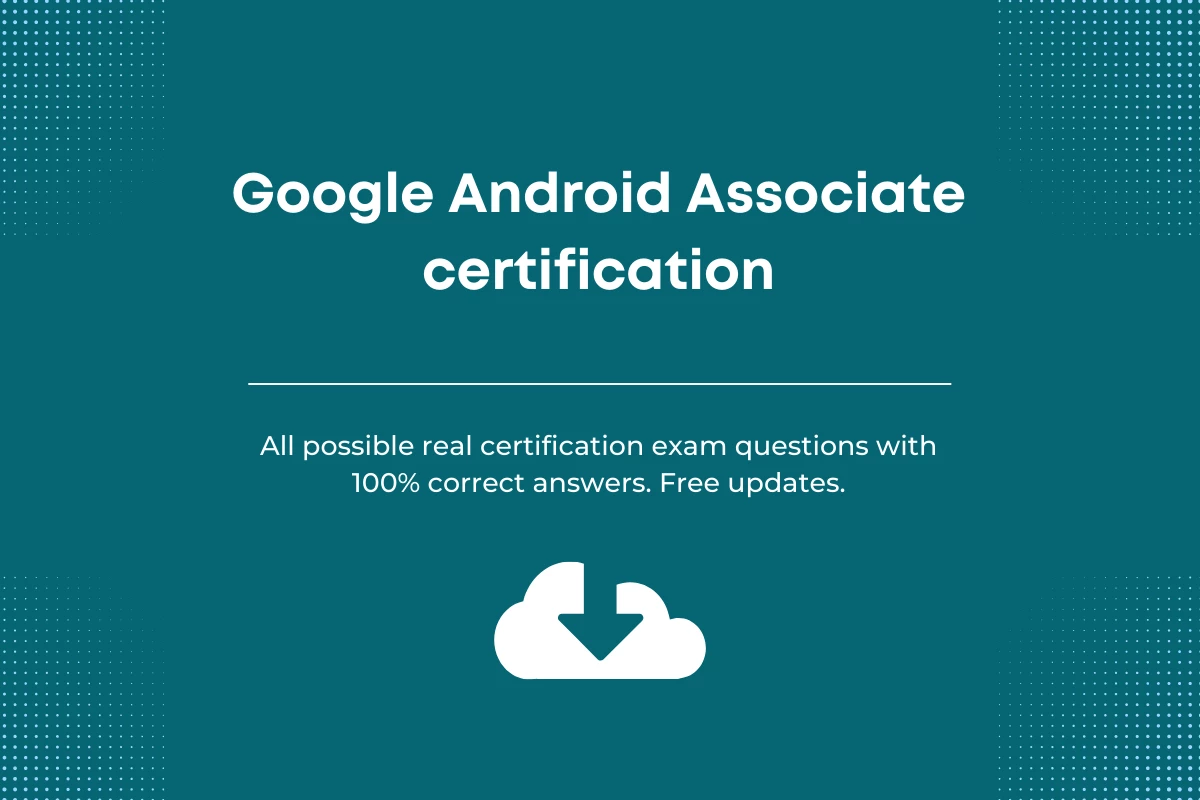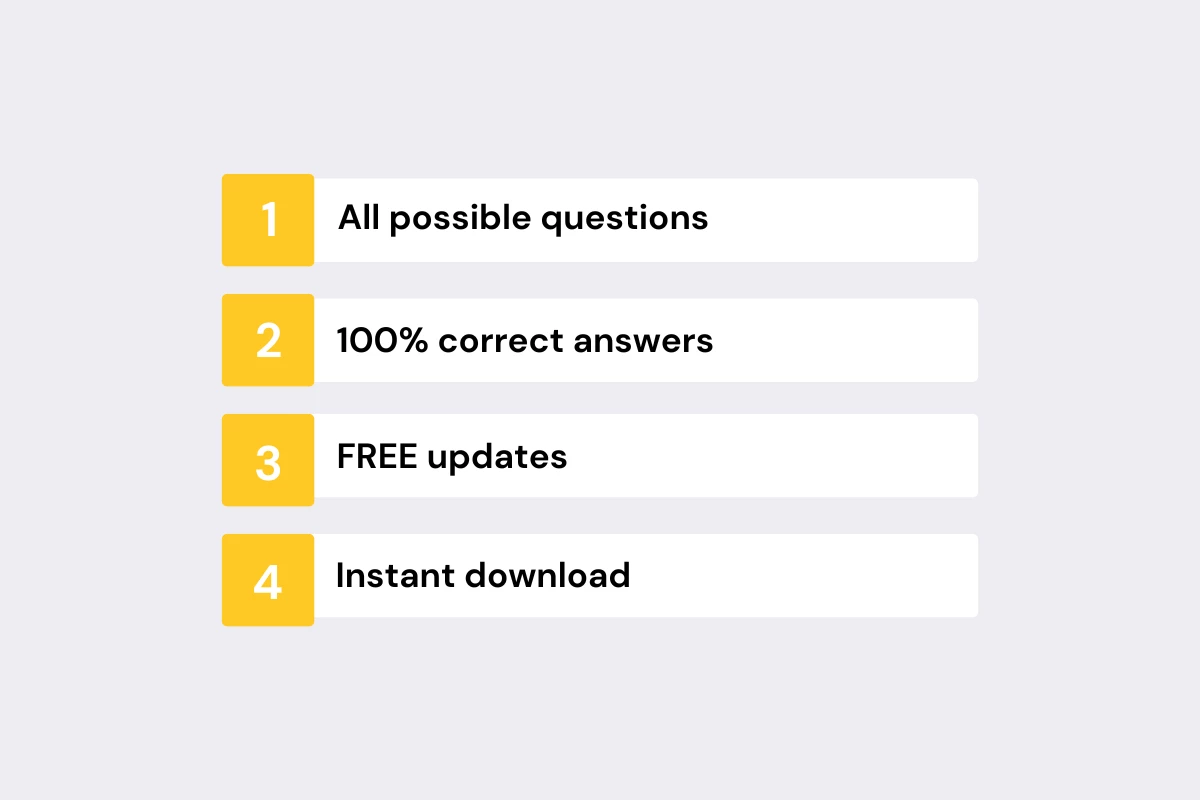This file contains all possible real exam questions with 100% correct and verified answers. Free updates included. Save your time.
Below you’ll find some selected questions from the latest real certification exam. You can get an idea about the exam format and prepare for it smarter. Need all exam questions with answers? Consider downloading our file.
Device management is widely used by organizations around the world. Which of the following is not an Enterprise Mobility use case that you probably often see in your daily life?
- Using an E-Menu tablet in a restaurant to place an order faster directly to the kitchen without calling the waiter.
- An employee using a managed Android device owned by the company that has been customized into a barcode scanner to perform a job faster anywhere.
- An employee uses his mobile device to send a message to his colleague to invite him to a friendly afterwork.
- None of above - they are all Enterprise mobility use-cases.
Bank Corp has a mixture of use cases in their organization. They have selected Android devices as their default choice for work. What are some of the management modes available to them? Select All Correct Responses
- Dedicated device
- Personally Enabled
- Bring Your Own Device (BYOD)
- Productivity
You have already selected the appropriate device required to meet your end-user’s requirements. What are the next stages of implementing the appropriate mobility solution for your end user? Select All Correct Responses
- Selecting device management modes
- Selecting device enrollment and distribution methods
- Establishing device update cadence
- Identifying an application management strategy
What are the stages of implementing a mobility solution?
- “1. Identify requirements and use case 2. Procurement 3. Device management 4. Application deployment to devices 5. Device enrollment and distribution 6. Operations and maintenance”
- “1. Identify requirements and use case 2. Procurement 3. Device management 4. Device enrollment and distribution 5. Application deployment to devices 6. Operations and maintenance”
- “1. Identify requirements and use case 2. Procurement 3. Application deployment to devices 4. Device enrollment and distribution 5. Operations and maintenance 6. Device management”
- “1. Procurement 2. Identify requirements and use case 3.Application deployment to devices 4. Device enrollment and distribution 5. Device management 6. Operations and maintenance”
Which of the following help to protect Android devices against security vulnerabilities? Select All Correct Responses
- Encryption
- Verified Boot
- Social engineering
- Regular and controlled updates
When deploying managed devices, there will be a few different organizations involved with a different roles and responsibilities. Which of the following parties is required to provide networks, supplying and distributing devices?
- Carrier/Device resellers
- OEM Manufacturers
- Service Providers
Who can add devices to a customer’s zero-touch account?
- The customer IT Admin
- The EMM provider
- The device manufacturer only
- The device reseller and/or their vendors (if enabled)
How often does Google issue Android security patches?
- Every 30 days
- Every 90 days
- Every 7 days
- Once a year
You are talking to Bina, the CIO of Sales LTD. They are concerned that apps on Android share data by default. You realize they could benefit from understanding Application Sandboxing a little better. How would explain this concept to Bina?
- Application Sandboxing encloses apps and data in their own virtual sandcastles, meaning that data can only be accessed by entering the end users passcode. It also protects against harmful users by crumbling the sandbox in the event a new user is discovered.
- Application Sandboxing ensures apps and data are able to share from others (like at a playground sandbox), meaning that data can be accessed by apps that do not have the authority. It also helps harmful app accessing any data from the OS or any other apps by throwing sand in the bad apps containers.
- Application Sandboxing is a technology that allows each app to create its own virtual sandbox and limit the end user from being able to copy and paste data from the app into another app.
- Application Sandboxing ensures apps and data are isolated from others, meaning that data cannot be accessed by apps that do not have the authority. It also protects against a harmful app accessing any data from the OS or any other apps.
Using an Android Enterprise EMM solution, IT admins can set up and apply over the air (OTA) system updates to devices under management. They also have the ability to decide when these updates are pushed out to the devices OTA in order to test them prior to being released. What are the options for IT admins to push out these updates? Select All Correct Responses
- Automatic Install: Device receives OTA update immediately
- Windowed: IT admin schedule OTA updates
- Postponed: IT admin delay OTA update for 30 days
- Blocked: OTA updates are permanently blocked
Passing exams is not a workout. Multiple attempts won’t make you stronger.
Save your time with our answer-sheets. Get certified in minutes.
Which of the following defines zero-touch?
(Zero-touch)
- Zero-touch is an enrollment method used for compatible Android devices.
- It is a device management solution.
- It is an alternative App distribution platform to Google Play.
- It is a custom enterprise solution.
Greg works at Company Sales Ltd and has asked you to enroll all their devices into zero-touch to ensure they cannot be used if they were lost or stolen. You realized that Company Sales Ltd does not have an EMM. What should you recommend to Greg?
(Zero-touch)
- Nothing to worry about. Greg does not need an EMM solution for zero-touch.
- An EMM solution is a requirement for zero-touch.
Who can add devices to a customer’s zero-touch account?
(Zero-touch)
- The customer IT Admin
- The EMM provider
- The device manufacturer only
- The device reseller and/or their vendors (if enabled)
Which Android Enterprise device enrollment method requires little to no interaction with an end user’s device from IT?
(Zero-touch)
- DPC
- NFC
- QR Code
- Zero-touch
Zen, an existing zero-touch customer, wants to purchase devices from a new reseller. What is the process he needs to follow to have his new devices enrolled in zero-touch from the new reseller?
(Zero-touch)
- Email Android Enterprise support team to open the request.
- Request a new zero touch account.
- Deregister all existing devices.
- Provide his customer ID and enable the new reseller in his Reseller list.
Who can deregister devices from the zero-touch portals?
(Zero-touch)
- The end users
- Only the reseller
- Only the customer
- Both customer and reseller
Android Enterprise creates “defense in depth” by using four layers of protection. Identify the two layers from the given list.
(Basics of Android Security)
- Hardware: Android devices have tamper-resistant hardware to ensure the OS hasn’t been compromised. Dedicated components handle critical tasks like encryption or screen lock.
- Google Play Protect: provides 24/7 mobile security that scans apps and devices. Using machine learning, it detects and blocks malware, constantly learning so it’s always up to date to protect users from the latest threats.
- Emojis: Android supports Emojis which are pictograms, smileys and other graphics used in electronic messages and web pages. The emoji’s primary function is to fill the end user with positive emotions to position them in happier and more secure place while using their device.
- Dynamic Wallpaper: Android Devices support animated background images that can be used as the devices wall paper that will confuse a would be hacker and discorage them from attempting to exploit the device.
Jana from Sales Ltd is worried about custom operating systems or malicious code being installed on her fleet of managed devices. You remember the concept of verified boot from your Android Enterprise training. How would you explain Verified Boot to Jana?
(Basics of Android Security)
- Verified Boot asks the user every single time what good version of the operating system they would like to boot up in.
- Verified Boot ensures the device will boot up within 30 seconds to prevent end users from becoming inpatient and attempting to root their devices.
- Verified Boot confirms all executed code has passed the code review by the companies IT department and they have authorized the device to access corporate IT resources such as email and apps.
- Verified Boot ensures all executed code comes from a trusted source (usually device manufacturers), and has not been modified by an attacker or corrupted. By verifying the OS it ensures a device will be running a safe version of Android.
The App Defense Alliance was created to ensure the safety of Google Play. What appropriate action can be taken to protect users?
(Basics of Android Security)
- All of these
- Scan results can be sent back to the partner and Google Play Protect receives analysis from the partner’s scanning engines to protect the users.
- New app risk intelligence can be generated as apps are being queued to publish and partners will analyze that dataset before the availablity of an app on Google Play to protect users.
- Partners of the App Defense Alliance can send a request to the Google Play Protect scanner service to have an app analyzed.
Mobile threat protection services are built into every Android device. Which of the following Google services keeps us safe while browsing websites?
(Basics of Android Security)
- SafetyNet
- Rollback Protection
- Google Play Protect
- Safe Browsing
You are talking to Bina, the CIO of Sales LTD. They are concerned that apps on Android share data by default. You realize they could benefit from understanding Application Sandboxing a little better. How would explain this concept to Bina?
(Basics of Android Security)
- Application Sandboxing encloses apps and data in their own virtual sandcastles, meaning that data can only be accessed by entering the end users passcode. It also protects against harmful users by crumbling the sandbox in the event a new user is discovered.
- Application Sandboxing ensures apps and data are able to share from others (like at a playground sandbox), meaning that data can be accessed by apps that do not have the authority. It also helps harmful app accessing any data from the OS or any other apps by throwing sand in the bad apps containers.
- Application Sandboxing is a technology that allows each app to create its own virtual sandbox and limit the end user from being able to copy and paste data from the app into another app.
- Application Sandboxing ensures apps and data are isolated from others, meaning that data cannot be accessed by apps that do not have the authority. It also protects against a harmful app accessing any data from the OS or any other apps.
Which of the following protects Android devices against security vulnerabilities?
(Basics of Android Security)
- Social engineering
- Encryption
- Regular and controlled updates
- Verified Boot
Which of the following is applicable for Bring Your Own Devices (BYOD)?
(Enterprise Mobility)
- BYOD protects the business while preserving user privacy.
- None of these.
- BYOD are personally owned devices.
- BYOD employ an Android work profile that separates work and personal apps.
Device management is widely used by organizations around the world. Which of the following is NOT an Enterprise Mobility use case that you probably often see in your daily life?
(Enterprise Mobility)
- An employee uses his mobile device to send a personal text message to his colleague to invite him to a friendly afterwork.
- Using an E-Menu tablet in a restaurant to place an order faster directly to the kitchen without calling the waiter.
- None of these - they are all Enterprise mobility use-cases.
- An employee using a managed Android device owned by the company that has been customized into a barcode scanner to perform a job faster anywhere.
What are the main benefits of using Android for business?
(Enterprise Mobility)
- 1.Flexibility 2. Personal 3. Affordable 4. Reliable
- 1.Security 2. High Cost 3. Scalability 4. Productivity Apps
- 1.Productivity Apps 2. Security 3. Deployment 4. Flexibility
- 1.Ease of use 2. Deployment 3. Budget 4. Security
What is Android Enterprise Essentials?
(Overview of Android Enterprise)
- Offered from Google, it is sold by select device resellers.
- It is built for businesses with lighter management needs.
- It provides security at an affordable price.
- It provides automatic and fast deployment without the need to create configurations.
One of the use cases that Android Enterprise offers is to allow the use of both personal and work in one device using work profile. What is the benefit of work profile?
(Overview of Android Enterprise)
- A work profile comes with a new mobile number offered by Google.
- A work profile can be set up on an Android device to separate work and personal apps/data. With a work profile you can securely and privately use the same device for work and personal purposes.
- A work profile is only helpful seperating network traffic.
- Work profile applications delete after every user session and install the next time automatically.
Mika, a new marketing intern, has enrolled her personally owned device into her employer’s EMM solution, known as the BYOD (Bring Your Own Device) use case. What can Mika’s IT manager do on her device in this case?
(Overview of Android Enterprise)
- Read personal text messages, view personal photos and capture all data on the device regardless it being personal or work data.
- Provide Mika with fully compliant access to company IT resources and apps completely separated by the work profile with no access to her personal profile and data.
- Fully erase the device at any time completely wiping the device of all data without the ability to only erase company data.
- Use the device processors to mine crypto currency when their device is charging at night while they sleep to earn bonuses.
You are talking to the procurement officer of Bank Corp. He asks about the Android Enterprise Recommended program and the device types that are listed. What are some of the device types that part of the Android Enterprise Recommended OEM program?
(Overview of Android Enterprise)
- Premium Devices, Budget Devices, Rugged Devices and Purpose Built Devices
- Only devices that have screens larger than 5.5 inches
- Only Premium devices
- Only Google Pixel devices
Lulu, the head of procurement for Bank Ltd, wants to purchase premium devices for their executives. They want to allow personal use on these devices, respecting the privacy of users but also being able to maintain control. What management mode would you suggest to Lulu?
(Overview of Android Enterprise)
- Fully Managed - Lulu should not allow personal use on company owned devices and that is also not recommended.
- BYOD - Lulu can simply ask all executives to setup their devices as personal devices, first with their Google accounts and then enroll them into management using a work profile.
- COPE - Lulu can deploy devices using COPE (corporate owned, personally enabled). With this, the user can get all the privacy protections of the work profile and IT can maintain control but not at the cost of user privacy.
- COPE - Lulu can deploy a work profile for each device and give the IT special access into the personal side also. Users should be warned that all data on their personal side is visible to IT at any time.
When deploying wifi only devices with zero-touch, what information is needed from the devices?
(Zero-touch)
- Model, Manufacturer, IMEI
- Manufacturer, Serial Number, MAC Address
- IMEI, Screen size, Serial Number
- Manufacturer, Model, Serial Number
Bank Corp is looking to deploy 3000 Android devices using zero-touch. What are some of the benefits of this type of deployment?
(Zero-touch)
- Increase productivity for users
- All of these
- Simplicity and flexibility for IT
- Enforced management and security for organizations
Liz, a customer, wants to turn on her zero-touch device for the first time. What does she need to do?
(Zero-touch)
- Literally nothing. Liz just needs to turn it on and not touch it.
- Go through the standard Android device set up, then add their company email account to begin the zero-touch enrollment process.
- Plug it in and let it charge for 24 hours prior to doing anything else and do not touch it.
- Simply power on the device, connect to a wifi or cellular data network and touch through the set up screens to automatically enroll the device on the company’s EMM solution and receive all the required configurations, apps and security policies.
How often does Google issue Android security patches?
(Basics of Android Security)
- Every 7 days
- Every 90 days
- Every 30 days
- Once a year
Which of the following provides 24/7 mobile security that scans apps and devices, detecting and blocking malware to protect users from the latest threats?
(Basics of Android Security)
- Safe Browsing
- Device Admin API
- Google Play Protect
- SafetyNet
When deploying managed devices, there will be a few different organizations involved with different roles and responsibilities. Which of the following parties is required to supply and distribute devices?
(Overview of Android Enterprise)
- Service Providers
- Device resellers
- OEM Manufacturers
Bank Corp, with a variety of use cases in their organization, have selected Android for their company-owned devices. What are the management modes available to use with their devices?
(Enterprise Mobility)
- Productivity
- Company-owned Personally Enabled Device
- Bring Your Own Device (BYOD)
- Company-owned Dedicated device
When can a customer get access to the zero-touch customer portal?
(Zero-touch)
- The EMM provider enrolls their devices.
- After the reseller creates an account for the customer.
- The customer signs up and creates it.
- The device manufacturer creates one for the customer.
What is the key benefit of the Google-built Android Enterprise Recommended program for Enterprise users?
(Overview of Android Enterprise)
- Because OEM’s and services pay to be part of the service, you can be confident that these services meet the high bar.
- Only devices and services on the list work with Android Enterprise.
- All Android Enterprise Recommended devices come with pre-installed enterprise applications by Google.
- This program helps Enterprise users to choose device model, EMM solutions and/or Service Providers that meet a higher enterprise requirement and are recommended by Google.





